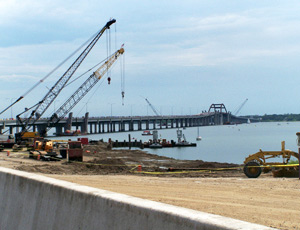After three years of construction, the $900-million Lake Lewisville Toll Bridge opened Aug. 1. The project faced several challenges including major floods in the spring and summer of 2007 that shut down work for two months.

Construction of the toll bridge began in October 2006; however, work ceased for 100 days in 2007 due to record-breaking precipitation that caused the lake level to rise, Susan Slupecki, spokeswoman for North Texas Tollway Authority, told Texas Construction.
The Dallas/Fort Worth metropolitan area experienced its second wettest June on record with almost 11 in. of rainfall. In response, the NTTA offered the construction contractor an incentive to recover the lost time.
The bridge opened with an event that allowed pedestrians a chance to walk across the bridge.
The NTTA completed construction on the LLTB on the east-west Lewisville Lake Corridor, a 13.8-mi stretch of road connecting IH-35E to the Dallas North Tollway.
“The NTTA is responsible for the design, construction and operation of the approximately 2-mi section that includes the 1.7-mi Lewisville Lake Toll Bridge,” Slupecki says “The LLTB weekday traffic is expected to be 10,000 to 15,000 vehicles per day in 2009.”
However, when the corridor is scheduled to be complete in 2013, the estimated traffic is expected to be 30,300 - “keeping in mind these are 24-hour two-way volumes,” Slupecki adds.
“Now that the bridge is open to traffic, there is no question the LLTB will help reconnect the Lake Dallas community to the rest of Denton County, providing motorists with a significantly faster commute,” she says.
“We took a sample path from an origin near Lake Dallas and a destination near Little Elm and were able to determine that without the LLTB, the shortest path is approximately 21.5 mi,” she says. “With the LLTB, the shortest path is around 5.4 mi,” she adds. Time savings for this origin-destination pair could be 22-28 minutes, depending on the time of day of travel, she says. “It may or may not represent an average commute, but it demonstrates the undertaking of getting from one side of the lake to the other.”
The added connectivity/mobility, she says, has an unquantifiable value. It will likely change some trip ends - origins or destinations - that were previously precluded.
The bridge’s 360-ft signature arch structure is designed to give area residents, motorists and boaters an easily recognizable landmark in southern Denton County.
The weathering steel arch has a natural oxide coating that when fully mature is dense and relatively impervious to atmospheric corrosion, adding to the bridge’s durability. The weathering steel requires less maintenance, which could mean a future cost savings for upkeep, according to the NTTA.
The bridge also has a storm water filtering system that meets U.S. Army Corps of Engineers standards and targets the most contaminated water, or first flush, the result of the .25-in. of rain, the time when the pavement is the dirtiest with oil and debris. The storm water-filter system promotes water quality by preventing contaminants from entering thestorm water and drainage system, lakes and streams by catching and treating the water before it returns to the lake. The LLTB is the only bridge in North Texas with that type of built-in storm water system.
The uncoated concrete beams are designed to provide aesthetic appeal to motorists and are more environmentally friendly than coated concrete because they do not release volatile organic compounds. A financial impact is associated because coated concrete is more expensive to make and maintain. By using uncoated concrete, there can be an upfront cost savings as well as a long-term cost savings since money will not have to be spent on repairs, or revenue lost from closing the road to make them, Slupecki says.
The total LLTB project is budgeted at approximately $122 million with construction costs totaling $98 million. The project is currently under budget with an actual cost of $118 million. The entire 13.8-mi LLTB corridor project is estimated to cost $220 million.
Dallas-based PBS&J provided construction management services for the 1.7-mi toll bridge over Lewisville Lake, in conjunction with Keville Enterprises of Dallas, Rodriguez Transportation Group of Lake Dallas and STL Engineers of Dallas.
The LLTB features a lighted tied arch spanning 360 ft above the four-lane bridge. The arch is made of weathering structural steel, weighing 1,900 tons, over the reinforced concrete bridge deck and concrete foundation.
The NTTA worked with Denton County; TxDOT; the U.S. Army Corps of Engineers; and the cities of Little Elm, Frisco, and Lake Dallas to develop the corridor.

Post a comment to this article
Report Abusive Comment